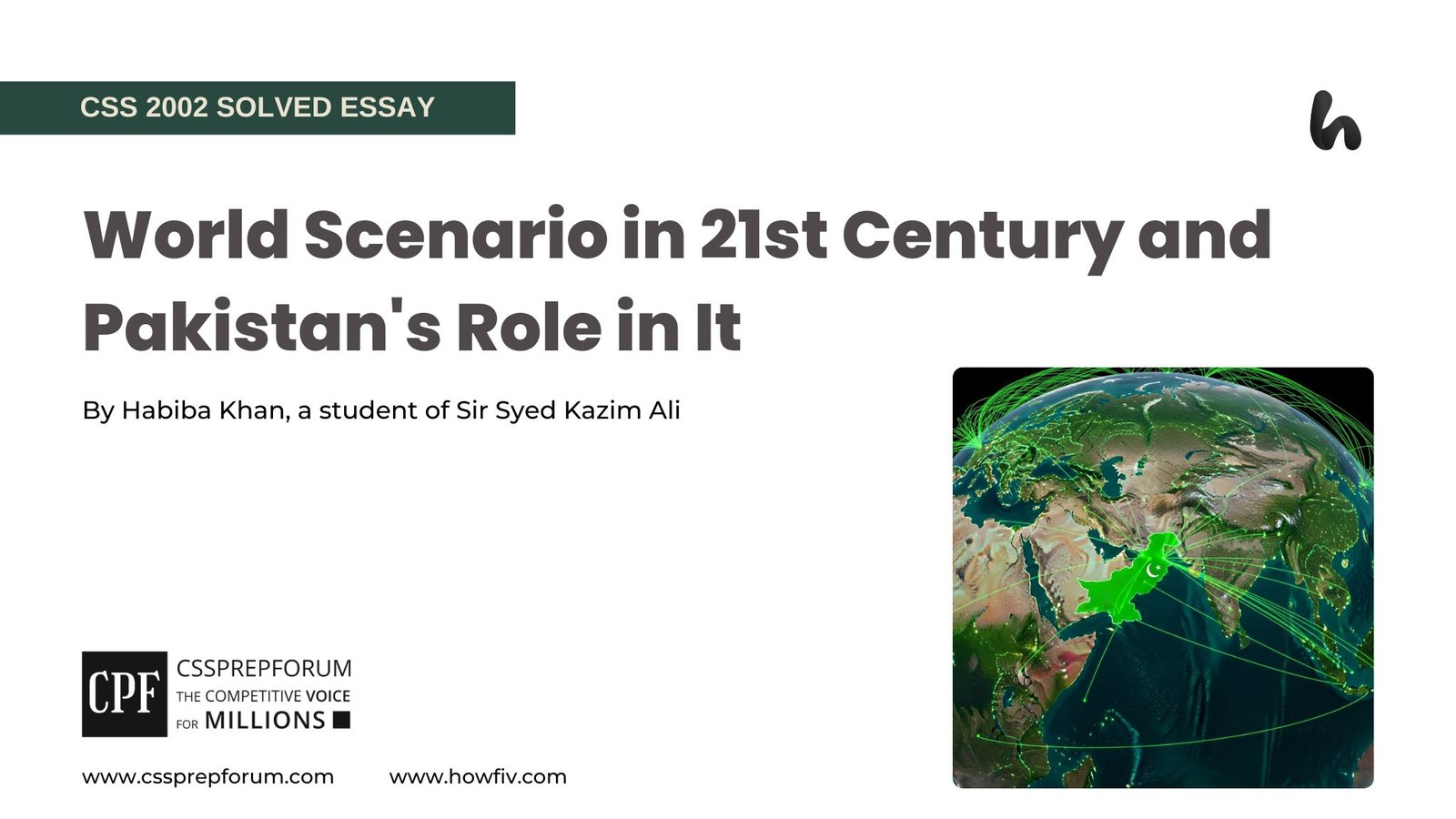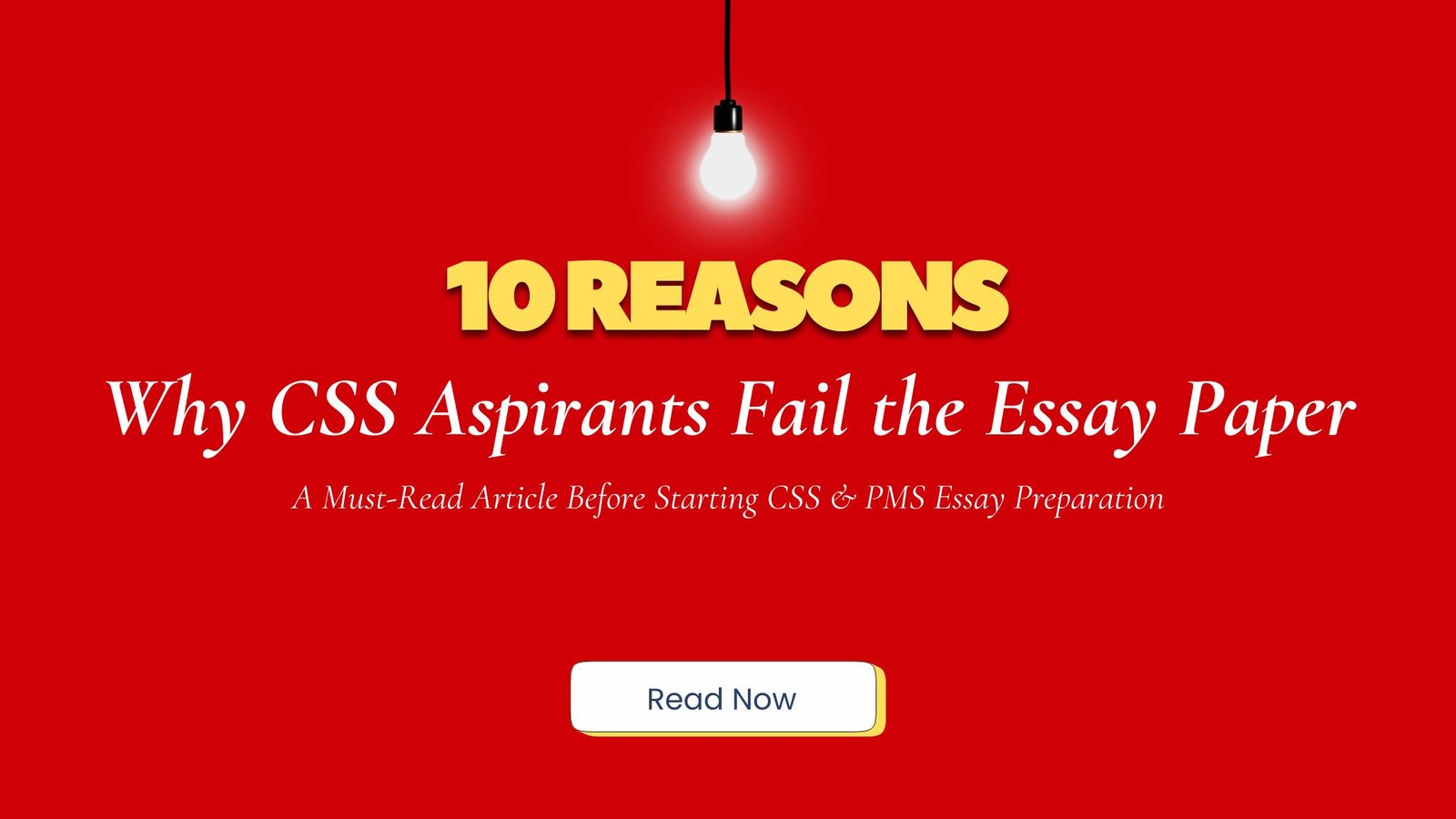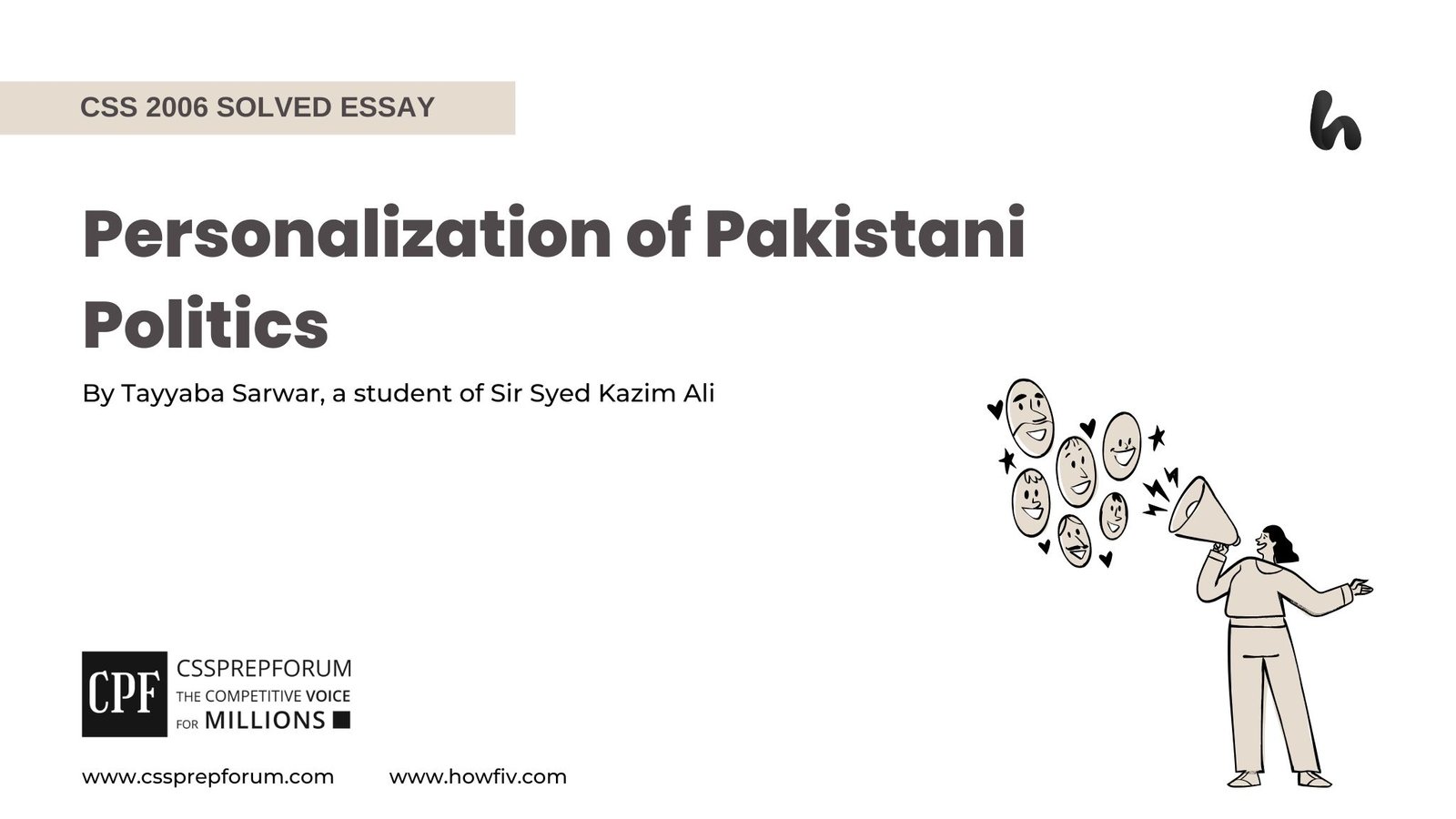CSS Current Affairs | Role of Social Media as a Tool for Propaganda
The following question of CSS Current Affairs is solved by Sadia Jabeen under the supervision of Howfiv’s Pakistan Affairs and Current Affairs Coaches. She learnt how to attempt 20 marks question and essay writing from Sir Syed Kazim Ali, Pakistan’s best CSS and PMS English essay and precis teacher with the highest success rate of his students. This solved past paper question is attempted on the pattern taught by Sir to his students, scoring the highest marks in compulsory and optional subjects for years, and uploaded to help aspirants understand how to crack a topic or question, how to write relevantly, what coherence is, and how to include and connect ideas, opinions, and suggestions to score the maximum.

Outline
1- Introduction
2- A bird’s eye view of social media
3- Relationship between politics and social media
4- The role of social media as a tool for propaganda
- ✓Targeting large and diverse public
- ✓Quick influencing of public opinion
- ✓Digital suppression of the opponents
- ✓Helping inexpensive political campaigning
- ✓Allow Unrestricted and uncensored communication/Speeches
5- Factors that make social media a powerful tool for propaganda
- ✓Industrial-scale manipulation
- ✓Private sector involvement
- ✓Professionalization and amplification
6- Case study representing the role of Social Media as a tool for propaganda by political entities globally
- ✓Indian Lok Sabah Elections 2024
- ✓Pakistan’s elections 2024
7- Possible measures to prevent the challenge
- ✓Transparency and accountability in political advertising
- ✓Increase awareness and education among citizens
- ✓Expanding fact-checking and verification system
- ✓Diverse voices and counter-narratives
8- Conclusion

Answer to the Question
Introduction
The role of political propaganda in contemporary global politics has been widely spread through social media platforms. These platforms have allowed political actors to spread misinformation and propaganda with great speed and efficiency, reaching vast audiences with minimal regulation or oversight. Political propaganda on social media takes various forms, including fake news, manipulated images and videos, and inflammatory rhetoric designed to provoke a reaction. Political actors have also used social media to spread conspiracy theories, discredit opponents, and promote their own political agendas. For this purpose, political entities use social media in various ways, such as through industry manipulation, private sector involvement, and professionalization and amplification. However, the propaganda could be prevented by taking critical measures: by making laws for transparency and accountability in a political advertisement, expanding the fact-checking and verification system, and amplifying diverse voices in the mainstream.
A bird’s eye view of social media
Social media refers to online platforms and technologies that enable users to create and share content, as well as engage in social networking and online communication. The development of social media can be traced back to the early days of the internet, with the advent of bulletin board systems and early online communities. However, in the early 2000s, social media began to gain widespread popularity and influence. The launch of platforms such as Friendster, MySpace, and LinkedIn marked the beginning of a new era of social media. Basically, it was the launch of Facebook in 2004 that truly revolutionized the field, paving the way for the rise of other social media giants like Twitter, Instagram, WhatsApp, and YouTube. Indeed, social media platforms allow social relationships between people of different languages, religions, and ethnicities by bringing them together in a virtual atmosphere. Its navigation has become a habit and need, and the social networks that have attracted great attention, especially from the young and children, continue to attract every age group; therefore, they spend a lot of time using them.
Relationship between politics and social media
The relationship between politics and social media began to be established in the mid-1990s when it started to be used for political campaigns; however, as with every new technology, social media usage was also limited in politics. Social media was actively used in politics for the first time by Barack Obama, who in 2008 was a candidate for presidency in the US presidential elections. In addition to receiving 52% of public support, Obama also achieved the success that no Democratic Party presidential candidate has achieved in the last 30 years. The role of social media behind this success was quite high. Obama acted in a very conscious manner that young people use social media more than they use traditional media. Obama, whose victory was called “a new media victory” more than his own victory, used social media rather than traditional media.
Today, social media has had a profound impact on politics, shaping the way people engage with political issues and influencing the outcomes of elections and other political events. Nonetheless, more than 90% of young internet users aged 15-29 also use social media, which has become a powerful tool for political actors to communicate their messages, mobilize supporters, and influence public opinion. That’s why political parties remain in constant political interaction with the public.
The role of social media as a tool for propaganda
- ✓Targeting large and diverse public
Compared to physical addressing where only a few and local inhabitants of the area can participate in the political meetings, social media help politicians to address and target large and diverse public from every part of country, or even world very easily because social media provide platforms where people can get together at any time and from anywhere. Social media allows real-time engagement and feedback, enabling politicians to gauge public sentiment and respond accordingly.
- ✓Quick Influencing of Public Opinion
Politicians use social media to shape public opinion in their favour. They do so by spreading carefully crafted narratives around their policy positions; politicians aim to shape public opinion in their favour. They also leverage emotional appeals to sway voters and create urgency around their policy proposals. According to studies on political communication, emotional appeals can significantly impact voter behaviour. For example, a politician evokes the fear of rising crime rates to advocate strict law enforcement policies.
- ✓Digital suppression of the opponents
Few politicians spread misinformation to discrete opponent candidates; they spread propaganda to suppress their political participation. For instance, investigations into misinformation campaigns during elections reveal that deliberated misinformation strategies have been used by political parties to suppress their rivals. Nevertheless, incumbent political parties use propaganda to discourage voter turnout; they use social media as a tool to spread conspiracy so that public perception regarding rival political parties can be manipulated.
- ✓Helping Inexpensive political campaigning
In contemporary times, Social media has become an essential part of digital campaigning. It not only provides cost-effective platforms for campaigning that require minimal financial investment as compared to traditional advertisement but also provides a quick opportunity to those who cannot participate physically. During election campaigns, political parties actively run digital campaigns, along with physical campaigns. The OII report also highlights that political parties and politicians running for office in 61 countries have used computational propaganda tools as a critical part of their digital campaigns. To illustrate, through hashtag campaigns and online movements, social media helps politicians for mobilizing support for their political purposes.
- ✓Allow Unrestricted and uncensored communication/Speeches
Social media allows politicians to bypass traditional media gatekeepers and communicate directly with their audience. Politicians use social media to share policy announcements, respond to events, and engage directly with constituents. They can manage their image, respond to criticism, and promote their ideas without relying solely on news outlets.Nevertheless, in case of negative media coverage, politicians use social media to present their side of the story without relying solely on traditional news outlets.Case studies of political crises demonstrate how politicians strategically use social media to manage their image.
Factors that make social media a powerful tool for propaganda
- ✓Industrial-Scale manipulation
Today, the use of social media for spreading misinformation has become so professional that it is even produced on an industrial scale. The comprehensive study conducted by the Oxford Internet Institute (OII) in 2020 analyzed more than 93% of countries -76 out of 81- using social media for spreading misinformation as part of political communication. For example, in India, during the general elections of 2024, political parties deployed thousands of bots and trolls to influence voters by spreading false narratives and manipulating trends.
- ✓Private Sector Involvement
Political entities also collaborate with private firms to achieve their purposes. A number of private companies play an increasing role in spreading computational propaganda by offering “disinformation-for-hire services” to the political parties. According to the OII report, private firms use strategic communications via bots and amplification methods to create the impression of trending political messaging. For instance, in Turkiye, private firms have been accused of offering social media services to create fake accounts and spread propaganda on behalf of the government.
- ✓Professionalization and Amplification
Different firms use bots and amplification techniques to create the illusion of trending political messages. Moreover, youth groups and volunteers also share campaign messages on their personal social media accounts, amplifying the reach. Private communication companies offer services to create and disseminate propaganda on behalf of political clients. According to the Pew Research Center, investigation journalism has exposed a number of firms that are involved in disinformation campaigns that work to target grassroots mobilization of the citizens. Therefore, political parties spend millions on the private sector “cyber troops” to drown out other voices of opposition parties on social media. To gain support for political ideology, political parties create special social media groups, such as youth groups, citizen influencers, and civil society organizations that function specifically to target different sectors of society.
Case study representing the role of Social Media as a tool for propaganda by political entities globally
- ✓Indian Lok Sabah Elections 2024
During the 2024 Indian Lok Sabah elections, two main political parties, the Bhartiya Janta Party (BJP) and the Indian Congress Party, have run digital campaigns to suppress each other. They have used AI-created fake videos, pictures, and memes to downfall the image of the opposite party. For this purpose, they hired social media teams to run WhatsApp, YouTube, and Ticktok communities and groups on different platforms. Not only do political parties run political campaigns to spread their agenda, but a young YouTuber, Dhruv Rathee, has also successfully run a campaign on YouTube and made the Indian public aware of the political process and the power of the vote. Moreover, he also exposed the fake and violent political agendas of the BJP to the public. His YouTube videos have been so influential that a number of international news channels have referred to his videos as “the big new phenomenon of the elections”.
- ✓Pakistan’s elections 2024
During the elections of 2024, Pakistani political parties also used social media platforms to run their political campaigns. To illustrate, Pakistan Tehreek-e-Insaf (PTI) has been at the top of the list in running online political campaigns because the party was not allowed to arrange processions and rallies due to security reasons, and its leaders, particularly Imran Khan, have been arrested by the security forces. Therefore, the party used the power of social media to carry out its political activities. Its party leaders arranged live seminars to direct contact with their followers on YouTube and Twitter. Apart from this, the party leaders spread AI-created video messages of Imran Khan to raise enthusiasm in the young party followers. Moreover, another political party, Tehreek-e-Labaik (TLP), which is a banned mainstream media channel, also used the power of WhatsApp and YouTube to run its political campaign during elections. Hence, today, social media has become the most effective way of propagating their political agenda.
Possible measures to prevent the challenge
- ✓Transparency and Accountability in Political Advertising
All stakeholders, including policymakers, scholars, and civil society organizations, should collaborate with each other to promote transparency in political advertising. For this purpose, a legal monitoring mechanism should be implemented to track political ads and ensure compliance with regulations, including clear labelling of sponsored content and disclosure of funding sources. In case of violation, social media platforms should be held accountable for their role in spreading propaganda.
- ✓Increase awareness and education among citizens
The government should educate citizens about recognizing and critically evaluating propaganda. Nevertheless, media literacy programs can enable people to identify misinformation and disinformation. Therefore, schools, colleges, universities, and community organizations should incorporate media literacy into their curricula. Moreover, public awareness campaigns should also be launched to educate users about the risks of propaganda and the importance of critical thinking.
- ✓Expanding fact-checking and verification system
Governments should support independent fact-checking organizations and verification systems because these entities play a critical role in debunking false claims and verifying information. Moreover, social media platforms should also be encouraged to collaborate with fact-checkers and prominently label misleading content so that misleading and false information can be prevented from spreading among the citizens.
- ✓Diverse Voices and Counter-Narratives
Governments should encourage social media platforms to prioritize content that counters propaganda narratives. Citizen influencers, activists, think tanks, and grassroots organization can provide alternative viewpoints for promoting diverse perspectives beyond mainstream politicians. Amplifying diverse point of view on the social platforms would prevent politicians from spreading negative propaganda.
Conclusion
In conclusion, social media serves as a powerful tool for political propaganda that allows political entities to manipulate public opinion, shape agendas, and suppress freedom of speech by adopting various means such as industry manipulation, private sector involvement, and professionalization and amplification. However, the propaganda could be prevented by making laws for transparency and accountability in a political advertisement, expanding the fact-checking and verification system, and amplifying diverse voices in the mainstream.

CSS Solved Past Papers’ Essays
Looking for the last ten years of CSS and PMS Solved Essays and want to know how Sir Kazim’s students write and score the highest marks in the essays’ papers? Then, click on the CSS Solved Essays to start reading them.
CSS Solved Essays
CSS Solved General Science & Ability Past Papers
Want to read the last ten years’ General Science & Ability Solved Past Papers to learn how to attempt them and to score high? Let’s click on the link below to read them all freely. All past papers have been solved by Pakistan’s top CSS GSA coach having the highest score of their students.
General Science & Ability Solved Past Papers












